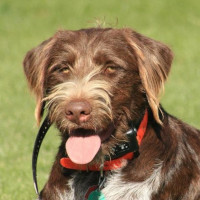Appearance of the Wirehaired Pointing Griffondor
|
| The Wirehaired Pointing Griffondor is a medium-sized dog, averaging 61 centimeters in height and 32 kilos in weight, with a medium-length outer coat and dense, waterproof undercoat. His general appearance is that of a sporting dog, as he is muscular and athletic, making him an excellent swimmer, as evidenced by his broad webbed paws. They have a slightly square head with a medium-length muzzle and folded ears, and often sport pronounced whiskers and eyebrows. Their tails are generally medium-length and tapered to help them swim, although some prefer to cut them off at half their length. Their coats range in color from black to white and brown to cream, and they usually wear at least two, one for their longer topcoat and the other for their shorter undercoat, giving them a distinct, untidy appearance. |
Temperament of the Wirehaired Pointing Griffondor
|
| Like its Labrador Retriever ancestry, the Wirehaired Pointing Griffondor is remarkably easy-going, and actively shows its affectionate side as often as possible. They are loyal, intelligent and obedient, making them easy to train, even with complex commands. Because of their friendly nature, high spirits and playful attitude, they make excellent family pets, as they get on well with adults, children, other dogs and other pets, even if they are only lightly socialized. They've even developed what breeders call a soft mouth - the ability to carry and use their mouths with surprising gentleness that doesn't interfere with the play they fetch, their toys or even their playmates. This is not necessarily true at birth, however, and they can become active biters as puppies who voluntarily exercise limited control if not properly trained. Because of their high energy levels, they can become restless, noisy or mischievous if not properly exercised. |
Needs and activities of the Wirehaired Pointing Griffondor
|
| The Wirehaired Pointing Griffondor, like both its parents, is a high-energy dog that needs regular space to run around, whether in a large fenced yard, in a dog park, or while cycling or jogging with its owners. They need 60 to 90 minutes of exercise a day, and an average week should include around 15 kilometers of running/walking. Training, playing and even taking part in regular activities such as fetching the mail or taking out the rubbish will help to keep them mentally and physically busy, as well as happy and healthy, and games such as ball games, where they have to run over vast expanses, are ideal for this purpose. Although intelligent and able to develop a slight sense of independence, Wirehaired Pointing Griffondors need frequent interaction. If left to their own devices, even in a large space, their boredom can become mischievous and sometimes destructive, which is why they often do best in large spaces, big homes and large families that can shower them with attention. |
Maintenance of the Wirehaired Pointing Griffondor
|
| Most maintenance for this breed is reserved for brushing. Although the two related breeds shed only seasonally, their double coats require weekly brushing to stay in tip-top shape. Despite their sometimes scruffy appearance, Wirehaired Pointing Griffondors are actually quite a clean breed and therefore only need a bath every couple of months, or when they decide to roll around in something nauseating, which is not uncommon for those allowed to walk off-leash. Their ears are the only other major source of maintenance problems, as excessive moisture build-up in their folded ears can encourage the growth of bacteria, making regular checks necessary. Their nails usually stay short naturally, with noticeable clicking noises being a good indicator of the need for trimming. Given the amount of food Wirehaired Pointing Griffondors consume, owners should also be prepared to have their pet's teeth brushed regularly, at least once a week, with a toothpaste suitable for dogs. Given their love of attention and bonding time, maintenance for this breed tends to be fairly easy and even enjoyable for both parties. |









 English (United Kingdom)
English (United Kingdom)